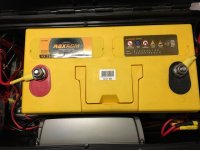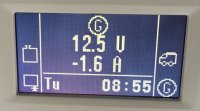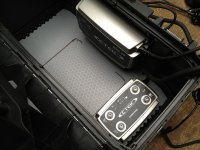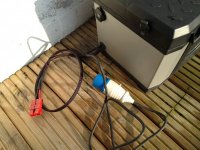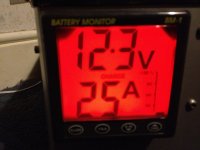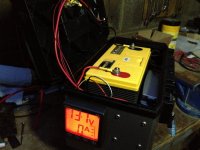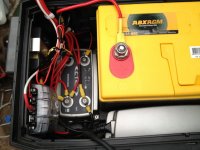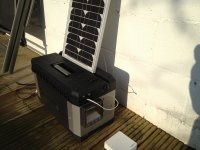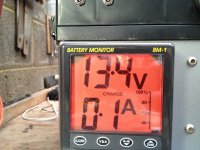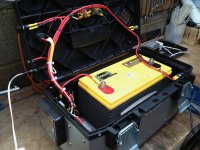T6 Dave's Dad
Member
Having discussed this with @Pauly he has suggested that this be posted here to enable members to make their own decision to vent AGM Batteries installed within the passenger compartment. It should also be noted that the VW factory installation includes venting (the tube in question is shown on the ETKA schematic for secondary batteries).
MY COMMENT: Failure to install venting could invalidate both the manufacturer's warranty and your insurance in the event of an incident that can be attributed by either to the battery being unvented. It is their way of avoiding liability. MY COMMENT ENDS.
I contacted VARTA (UK) for their advice and the trail of emails is below with the latest at the top. The VARTA (UK) position with regard to venting is clear and you may wish to read the whole of my contact with them
From: VB-UK-Enquiries BG-EUR-DE
Date: Thursday, 16 February, 2017
Subject: RE: Contact Us Form Submission
To: John
Dear John,
We don’t supply the tubing, but any correctly sized tubing will be fine.
Best regards,
Debbie
Debbie F*******
Key Account Representative
Johnson Controls Power Solutions EMEA
Email:
================================================================
From: John
Sent: 15 February 2017 09:52
To: VB-UK-Enquiries BG-EUR-DE
Subject: RE: Contact Us Form Submission
Dear Debbie,
Thank you for that additional information and I will now seek to pass on the information and educate others. I do know that VW fit vent tubes to their leisure batteries but even a seasoned auto-electrician pooh-poohs that by saying "that is because they have always done it".
Is it possible to purchase vent tubes to fit or will any correct sized tubing suffice ?
Thank you once again for your assistance.
John
Sent from AOL Mobile Mail
===========================================================
From: VB-UK-Enquiries BG-EUR-DE
Date: Thursday, 15 February, 2017
Subject: RE: Contact Us Form Submission
To: John
Dear John,
AGM batteries gas at a much slower rate than conventional lead acid batteries so this is maybe why they are saying that it is not needed.
Best regards,
Debbie
Debbie F*******
Key Account Representative
Johnson Controls Power Solutions EMEA
===============================================================
From: John
Sent: 14 February 2017 17:22
To: VB-UK-Enquiries BG-EUR-DE
Subject: RE: Contact Us Form Submission
Debbie,
Thank you for your advice as there is some disagreement with installers about the necessity to vent an AGM Battery to atmosphere if installing within the passenger compartment.
John
Sent from AOL Mobile Mail
=========================================================
From: VB-UK-Enquiries BG-EUR-DE
Date: Thursday, 14 February, 2017
Subject: RE: Contact Us Form Submission
To: John
Dear Mr *******,
It is advisable to vent the battery so that any fumes that are generated will be taken outside of the vehicle.
Best regards,
Debbie
Debbie F*******
Key Account Representative
Johnson Controls Power Solutions EME
===========================================================
From: pulsedigitaltechnology@teamdetroit.com [mailto ulsedigitaltechnology@teamdetroit.com]
ulsedigitaltechnology@teamdetroit.com]
Sent: 12 February 2017 15:39
To: info-uk@varta-automotive.com
Subject: Contact Us Form Submission
There has been a submission of the form Contact Us through your concrete5 website.
*Comments/Question I intend fitting a Varta AGM Leisure Battery under the driver's seat of a VW Transporter. Is it advisable to connect a vent tube to vent the battery to atmosphere ?
*First Name: John
*Last Name: **********
MY COMMENT: Failure to install venting could invalidate both the manufacturer's warranty and your insurance in the event of an incident that can be attributed by either to the battery being unvented. It is their way of avoiding liability. MY COMMENT ENDS.
I contacted VARTA (UK) for their advice and the trail of emails is below with the latest at the top. The VARTA (UK) position with regard to venting is clear and you may wish to read the whole of my contact with them
From: VB-UK-Enquiries BG-EUR-DE
Date: Thursday, 16 February, 2017
Subject: RE: Contact Us Form Submission
To: John
Dear John,
We don’t supply the tubing, but any correctly sized tubing will be fine.
Best regards,
Debbie
Debbie F*******
Key Account Representative
Johnson Controls Power Solutions EMEA
Email:
================================================================
From: John
Sent: 15 February 2017 09:52
To: VB-UK-Enquiries BG-EUR-DE
Subject: RE: Contact Us Form Submission
Dear Debbie,
Thank you for that additional information and I will now seek to pass on the information and educate others. I do know that VW fit vent tubes to their leisure batteries but even a seasoned auto-electrician pooh-poohs that by saying "that is because they have always done it".
Is it possible to purchase vent tubes to fit or will any correct sized tubing suffice ?
Thank you once again for your assistance.
John
Sent from AOL Mobile Mail
===========================================================
From: VB-UK-Enquiries BG-EUR-DE
Date: Thursday, 15 February, 2017
Subject: RE: Contact Us Form Submission
To: John
Dear John,
AGM batteries gas at a much slower rate than conventional lead acid batteries so this is maybe why they are saying that it is not needed.
Best regards,
Debbie
Debbie F*******
Key Account Representative
Johnson Controls Power Solutions EMEA
===============================================================
From: John
Sent: 14 February 2017 17:22
To: VB-UK-Enquiries BG-EUR-DE
Subject: RE: Contact Us Form Submission
Debbie,
Thank you for your advice as there is some disagreement with installers about the necessity to vent an AGM Battery to atmosphere if installing within the passenger compartment.
John
Sent from AOL Mobile Mail
=========================================================
From: VB-UK-Enquiries BG-EUR-DE
Date: Thursday, 14 February, 2017
Subject: RE: Contact Us Form Submission
To: John
Dear Mr *******,
It is advisable to vent the battery so that any fumes that are generated will be taken outside of the vehicle.
Best regards,
Debbie
Debbie F*******
Key Account Representative
Johnson Controls Power Solutions EME
===========================================================
From: pulsedigitaltechnology@teamdetroit.com [mailto
Sent: 12 February 2017 15:39
To: info-uk@varta-automotive.com
Subject: Contact Us Form Submission
There has been a submission of the form Contact Us through your concrete5 website.
*Comments/Question I intend fitting a Varta AGM Leisure Battery under the driver's seat of a VW Transporter. Is it advisable to connect a vent tube to vent the battery to atmosphere ?
*First Name: John
*Last Name: **********

